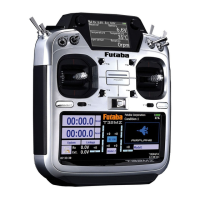
Do you have a question about the FUTABA 32MZ and is the answer not in the manual?
| Brand | FUTABA |
|---|---|
| Model | 32MZ |
| Category | Remote Control |
| Language | English |
Details product usage, export regulations, and unauthorized modifications.
FCC compliance and RF radiation exposure limits for the device.
Industry Canada RSS standard compliance and RF exposure limits.
EU compliance with Directive 2014/53/EU and available internet address.
Guidance on flying locations and contacting the Academy of Model Aeronautics.
Covers application, export, modification, and safety markings.
Warnings for safe flying, antenna handling, and operational advice.
Prohibited flying locations and battery/charger handling safety.
Precautions for handling, storage, and disposal of microSD cards.
Precautions for fuel exposure, metal parts, and using genuine products.
Details systems like FASSTest, channel expansion, S.BUS2, displays, and OS.
Lists package contents and technical details of transmitter and receiver.
Controls, antenna, LED, switches, volume, levers, trims, buttons, touch panel.
Adjusting stick lever length, angle, tension, and throttle stick system.
Battery exchange, charging, and associated warnings.
Storing files, warnings, and reading data from microSD cards.
Trainer, S.BUS, Audio, Charger connectors, CRSF, receiver nomenclature, modes.
Antenna installation, S.BUS, S.BUS2, and Telemetry systems.
Procedures for turning the transmitter on/off and start-up modes.
Description of the Home screen menus and elements.
Displaying timer or telemetry data on the sub-display.
Step-by-step guide for linking the receiver and transmitter.
Safety function to prevent incorrect model data usage.
Adjusting values, activating functions, and screen navigation.
Selecting switches, and displaying operation status messages.
Expanded displays and panel lock for flight safety.
Registering a user name and setting a PIN for data protection.
Setting up airplane and glider models, including model addition.
Setting up helicopter models, including model addition and swash types.
Automatic channel assignment for optimal servo combinations.
Channel assignments for helicopter models based on system type.
Setting transmitter functions not related to model data.
Setting up and using the trainer system for instructors and students.
LCD screen adjustment and auto power off settings.
Setting system clock and resetting the integrating timer.
User name registration and PIN setting for data protection.
Toggle switch type setting and operation mode selection.
Adjusting stick, switch, trim, and knob operation directions.
Calibrating sticks and adjusting servo response/hysteresis.
Adjusting volume for key operations, warnings, and timer events.
Music playback from microSD card and file management.
Setting up S.BUS servos, including ID number and parameters.
Detailed explanation of S.BUS servo parameters like ID, Reverse, Servo Type.
Displays program version, microSD card data, and product ID.
Choosing between metric and yard-pound systems for telemetry values.
Performing a ground range check to verify transmission range.
Overview of functions for model setup, channel assignment, and basic settings.
Testing servo movement and displaying servo positions.
Model addition, deletion, copy, and name setting.
Selecting model type (airplane, helicopter, glider) and related settings.
Wing, tail, and swash type selections for different models.
Setting a picture for the home screen to identify models.
Sound recording, playback, and voice file assignment.
Assigning audio files to switches for playback.
System mode selection and linking the receiver to the transmitter.
Step-by-step guide for linking receiver and transmitter.
Examples of choosing system types based on receiver features.
Changing channel assignments for functions and controls.
Swapping functions and changing trim modes.
Setting servo neutral position and fine-tuning linkages.
Reversing servo throw direction for proper control surface movement.
Setting servo positions for lost signals or low battery.
Adjusting servo travel, limit point, and speed.
Safely stopping the engine using a switch with throttle at idle.
Lowering engine idling speed via a switch with throttle at idle.
Limiting swash plate travel to prevent linkage damage (Helicopter only).
Swash linkage correction for Aileron, Elevator, Pitch.
Timer setup, lap time display, and operation modes.
Displays position of dials, sliders, and digital trims.